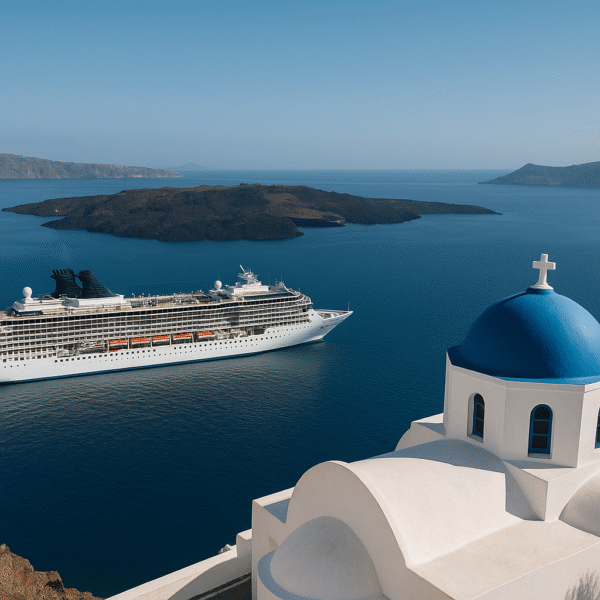Greece has officially rolled out new disembarkation fees for cruise passengers arriving at some of its most iconic islands, including Santorini, Mykonos, Crete, Corfu, and Rhodes. This initiative, which took effect on August 1, 2025, is a strategic response by the Greek government to address long-standing concerns related to overtourism, environmental strain, and infrastructure pressure on these high-traffic destinations.
The new entry fees affect all cruise passengers, regardless of cruise line, and are charged per disembarkation at each island. Under the current pricing structure, passengers arriving on Santorini or Mykonos must pay €20 per visit during the peak tourist season, while those visiting Crete, Corfu, Rhodes, and other islands face a €5 per visit charge. Beginning October 1, the fees will reduce to €12 for Santorini and Mykonos, and €3 for the other islands, coinciding with the tapering of the summer season.
Why the Fees Were Introduced
Greece, which welcomes over 30 million international visitors annually, has seen an overwhelming influx of cruise tourists in recent years. Islands like Santorini and Mykonos, with populations of less than 20,000 residents, are often inundated with several thousand tourists daily during peak months. According to the Hellenic Ministry of Tourism, these numbers can triple the local population on any given summer day.
The newly implemented disembarkation fees are part of a broader government strategy that emphasizes sustainable tourism, infrastructure development, and regional balance. The policy aligns with Greece’s “National Sustainable Tourism Strategy 2030,” which aims to regulate mass tourism, mitigate environmental impact, and channel tourism revenue into long-term improvements.
The government estimates that these new fees could generate between €50 million to €100 million annually. Funds collected will be allocated to improve waste management, freshwater supply, and coastal preservation, particularly in port towns that face seasonal overburdening of public services.
Impact on Cruise Passengers and Itineraries
The implementation has caught some passengers off guard, especially those who had already prepaid for cruises months before the fees were announced. Cruise lines like Royal Caribbean, MSC Cruises, and Norwegian Cruise Line have issued notices stating that the disembarkation fees will be automatically charged to passengers’ onboard accounts (such as SeaPass) unless they choose not to disembark at the affected ports.
However, travelers who booked cruises after September 2024, when the policy was publicly introduced, are less affected, as the fees were incorporated into their booking costs.
For example, a traveler with a seven-night cruise itinerary stopping at Mykonos, Santorini, and Crete during August would incur €45 in disembarkation fees, added to their final bill onboard.
Encouraging Year-Round Tourism and Lesser-Known Islands
Greek authorities hope that the seasonal and tiered nature of the fees will encourage visitors to explore the islands during spring and autumn, thereby reducing summer congestion and extending the tourism season. Additionally, by increasing costs at overburdened destinations like Santorini and Mykonos, Greece aims to direct tourist flow to lesser-known islands such as Naxos, Milos, Syros, and Lemnos, which have untapped tourism potential but often remain overshadowed by their more famous counterparts.
This redistribution of tourist traffic is not just a sustainability effort but also a boost for local economies outside the primary tourist trail.
How Greece Compares Globally
Greece is not alone in adopting such policies. Other popular European destinations grappling with overtourism, such as Venice, Italy, have introduced similar measures, including daily tourist caps and entry fees. Barcelona, Spain, is also considering limitations on cruise ship traffic in a bid to maintain urban quality of life.
In Greece’s case, the policy has garnered mixed reactions. Environmental and sustainability advocates have applauded the move as a necessary measure to protect natural and cultural heritage. On the other hand, some tourism stakeholders fear that such fees may deter certain segments of travelers or place added burdens on family budgets.
Advice for Travelers
Travelers planning a Mediterranean cruise that includes Greece in their itinerary are strongly advised to confirm with their cruise operator whether the new disembarkation fees are included in the overall fare or will be charged onboard. It’s also a good idea to check the cruise itinerary for the number of island stops to better estimate added costs.
Cruise passengers who prefer to avoid extra charges may choose to remain onboard during Greek island port calls. However, considering the unparalleled beauty, history, and cuisine of these islands, most travelers may still find the added fees a small price to pay.
Final Thoughts
Greece’s introduction of cruise disembarkation fees signals a turning point in global tourism, emphasizing quality over quantity and long-term sustainability over short-term gains. With increasing global attention on climate change, local preservation, and community wellbeing, such initiatives could become the new norm for high-traffic destinations worldwide.
As cruise tourism continues to evolve, Greece’s bold steps may pave the way for other nations looking to balance economic growth with environmental stewardship.
For more travel news like this, keep reading Global Travel Wire
















